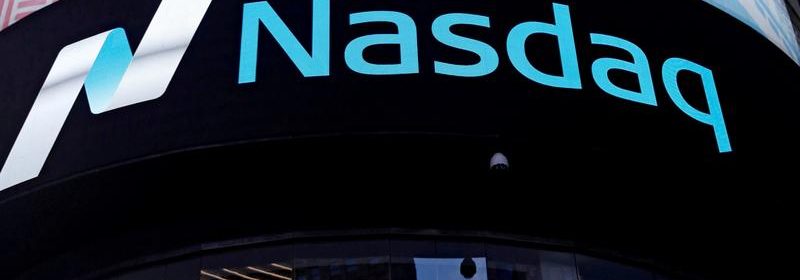Nasdaq surges as tech stocks roar back

(Reuters) – U.S. stocks rallied on Tuesday, with the Nasdaq gaining about 4% to recoup heavy losses from the previous session as U.S. bond yields retreated and investors scooped up battered technology stocks.
Tesla Inc jumped the most in almost a year, while Amazon.com Inc and Microsoft Corp posted the biggest single-day gains in five weeks. The tech stars suffered sharp losses in recent weeks as rising yields raised concerns over their high valuations.
The Nasdaq posted its biggest single-day rise since Nov. 4. The Dow set a record intraday high but pulled back from earlier gains at the close.
News that a $1.9 trillion coronavirus relief package was nearing final approval sparked a spike in yields on Monday, pushing the tech-heavy Nasdaq to end more than 10% below its Feb. 12 closing high, confirming a correction for the index.
U.S. 10-year Treasury note yields eased to as low as 1.523% after hovering near 13-month highs of 1.613% on Monday. Longer-dated yields have jumped over the last month as investors price in a faster rebound and higher inflation that expected at the start of the year.
The market is adjusting to the new level in interest rates, said Kristina Hooper, chief global market strategist at Invesco in New York.
Companies whose products and services are in demand when the economy is doing well, known as cyclicals, and small-cap stocks will outperform this year, she said. Tech will end the year higher but not be the leader as it was in the past year’s rally.
“Today the 10-year is down a bit, and that takes pressure off valuations, so tech is performing well,” Hooper said. “The market is just about getting comfortable at this level of rates.”
Rising rates disproportionately hurt high-growth tech companies because they are valued on earnings expected years into the future rather than profits earned in the short term.
“Potential headwind for the market is (when) interest rates rise further from this point over the short period … since they have risen too fast in too little time,” said Michael Sheldon, chief investment officer at RDM Financial in Westport, Connecticut.
The Dow Jones Industrial Average rose 30.3 points, or 0.10%, to 31,832.74, the S&P 500 gained 54.09 points, or 1.42%, to 3,875.44 and the Nasdaq Composite added 464.66 points, or 3.69%, to 13,073.83.
Volume on U.S. exchanges was 13.88 billion shares, compared to the 15.25 billion average for the full session over the last 20 trading days.
The rise in Treasury yields has accelerated a rotation from “stay-at-home” winners to stocks primed to benefit from the economy’s reopening, setting the blue-chip Dow on pace to end at a record high on Tuesday.
While the Russell 2000 growth index jumped 3.3% on Tuesday, compared to a 0.1% rise in Russell 2000 value index, it has sharply underperformed its value counterpart since the start of the month.
Shares of Tesla rebounded 19.6% from a deep sell-off that pushed shares down 37% from its peak in January to Monday. It was the largest percentage gainer on both the S&P and the Nasdaq 100.
The global economic outlook has brightened as vaccine rollouts gain speed and the United States launches a massive new stimulus package, the Organization for Economic Co-operation and Development said, hiking its 2021 growth forecasts.
The Democrat-controlled U.S. House of Representatives will take up the relief bill on Wednesday, with the chamber’s expected approval leading to President Joe Biden’s signing the legislation into law later this week.
The bank index fell 1.7% after vaulting to a new 14-year peak. Economy-linked financials, materials and industrials hovered near record highs.
GameStop also rallied 26.9%, building on Monday’s gain of over 40% on the video retailer’s e-commerce strategy and speculation that small investors will pour stimulus checks into markets.
Advancing issues outnumbered declining ones on the NYSE by a 1.78-to-1 ratio; on Nasdaq, a 2.83-to-1 ratio favored advancers.
The S&P 500 posted 37 new 52-week highs and no new lows; the Nasdaq Composite recorded 240 new highs and 17 new lows.
Source: Read Full Article
